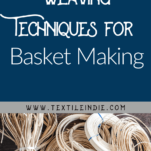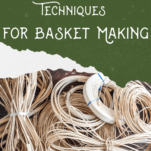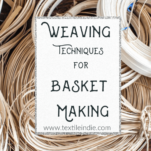Basketry is an ancient craft, and there are various weaving techniques for basket making. In this guide, we’ll explore some of the most popular methods.
(Visit the main Basket Weaving Page for a complete guide to all Textile Indie’s basket weaving posts and videos.)
Exploring different weaving techniques for basket making
What is plain weave?
Plain weave is also known as a simple weave.
Plain weave is done by following an over-one, under-one pattern of weaving.
The over-one, under-one pattern alternates from row to row so that the stakes are also going over one, under one vertically.

What is twill weave?
Twill weave is a style of weaving where the weaver goes over a certain number of stakes and under a certain number of stakes in an alternating pattern.
Each row creates a pattern similar to the diagonals in denim jeans material.
Twill 2-2
This twill, called a two-to-two-twill, is where the weaver is going over two stakes and then under two stakes. The next row alternates that pattern so that a stair-step pattern forms.
Twill 1-2
This twill is called a one-to-two-twill. This is when the weaver goes under one and over two around the basket and then alternates as you proceed with the rows.
What is twining?
Twining in basket weaving is used to hold the base in place once the base has been woven.
See Twining the Base: Creating a Stable Basket for more on that technique.
Twining can also be used to build the walls of a basket. The cross-over of the two pieces of the twining between each stake creates a twisted look on the sides of the basket.
What is braiding in basket weaving?
Braiding is used as a decorative technique. It’s typically more advanced and involves working with multiple weavers simultaneously to create the braid.


Do you want the best resources, tools, and products for fiber artists?
Every other Friday, I send an email chock full of fiber craft inspiration for you to explore.
Each issue focuses on one fiber art skill – spinning, dyeing, basket weaving…
What is a weave brake?
A weave brake is when you end one row or weaver and begin a new row or weaver.
Start-and-stop weave
This is one row at a time weaving. Weave around the basket, all the way around, and then overlap the ends, so they are tucked away from sight.

What is continuous weave?
The continuous weave is often used in a round basket where the weaver is woven around and around until you reach the end of a length of reed, and then you add in a new weaver.

We offer several basket weaving courses; try our Beginner Basket Weaving Bean Pot Basket video course to learn continuous weaving.
What is chase weave?
Chase weave involves two weavers being woven at the same time. The ends of the weavers are trimmed down and woven into the basket on the same side, so as the walls form, they are even. When you get to the end of one or both of the weavers, you add in a new length of reed just like you would for a continuous weave.
Specialty weaving
What is wave weaving in basketry?
Adding a weaver into the sides of a basket that crosses over the working weavers creates an ‘x’ shape, called a wave, on the outside of the basket.
What is French ranging?
French randing is a technique used to create a diagonal weave in the walls of a basket. Randing is excellent for using up shorter pieces of reed. Weave the base of a basket as usual and then weave the walls up at a forty-five-degree angle.
You can learn all of the basket weaving techniques in our Basketry Immersion program.
Find a complete list of basket weaving terminology:
For a complete guide to all Textile Indie’s basket weaving posts and videos, visit the main Basket Weaving Page.
More basketry posts:
With these weaving techniques for basket making under your belt, you’re well on your way to crafting beautiful and functional basket.
Basketry Immersion: A Year-Long Journey
Check out Textile Indie’s self-paced basket program if you want to learn to weave beautiful baskets.
Twelve different basket designs with video and written instructional support to learn foundational basketry techniques.
Over the course of twelve months, you will receive one basket pattern and a video with supporting instructional material each month. Start at basket one and weave all twelve.















